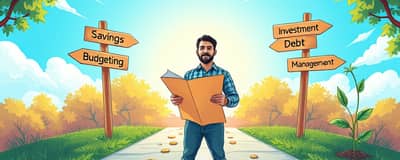Emergency Fund Essentials: Your Step-by-Step Guide to Building a Safety Net

An emergency fund is a crucial aspect of personal finance, providing a financial buffer in times of unexpected expenses. Whether it's a medical emergency, job loss, or urgent home repairs, having this fund can make a significant difference in how you handle financial stress. In this guide, we will outline the essentials of building an emergency fund, ensuring you can create a robust safety net for yourself and your family.
Understanding the importance of an emergency fund is the first step toward financial stability. It allows you to navigate life's surprises with confidence, preventing you from relying on high-interest credit cards or loans that can lead to further financial strain. This financial cushion not only helps you through tough times but also gives you peace of mind knowing you are prepared for the unexpected.
In the following sections, we will discuss how to determine the right amount to save, the best places to keep your fund, and practical steps to build and maintain it. By following this step-by-step guide, you will be well-equipped to establish a solid emergency fund that protects your financial future.
Why You Need an Emergency Fund

An emergency fund is more than just a safety net; it is an essential financial tool that helps you manage unplanned expenses gracefully. Life can be unpredictable, and having these funds available allows you to address emergencies without derailing your financial plan. It empowers you to make informed decisions without the added stress of financial instability.
Imagine facing a sudden medical bill, car repair, or a job loss. If you have an emergency fund, you can handle these situations without the need for high-interest loans or credit cards, which often accumulate debt more rapidly than you can pay it off. The peace of mind that comes with financial security cannot be overstated, especially in today’s uncertain economic climate.
Moreover, an emergency fund fosters a sense of discipline and financial responsibility. It encourages you to save consistently, build good financial habits, and understand the value of planning for the future. Starting this journey can seem daunting, but the benefits far outweigh the challenges. You will not only safeguard your current situation but also set yourself up for long-term stability.
- Provides financial security during tough times.
- Prevents reliance on credit cards and high-interest loans.
- Promotes discipline and good financial habits.
Overall, an emergency fund is a vital component of any financial strategy. It is not merely an extra source of cash; it is a safety net that can help you rise above unforeseen difficulties without falling into a cycle of debt.
How Much Should You Save?

Determining the right amount to save for your emergency fund can initially feel overwhelming, but it is essential for setting a solid foundation. The general recommendation is to aim for three to six months' worth of living expenses. This range can provide sufficient coverage for most emergencies.
- Evaluate your monthly expenses such as rent/mortgage, utilities, groceries, and insurance.
- Consider your job stability and any potential income sources.
- Adjust your target based on personal circumstances or financial commitments.
Ultimately, the goal is to have enough savings to meet your needs without unnecessary stress. Tailoring your emergency fund to fit your individual lifestyle and circumstances will ensure that you are well-prepared for any financial setbacks.
Where to Keep Your Emergency Fund

Having a specific account for your emergency fund is important for managing your savings effectively. It should be easily accessible, so you can quickly access it in the event of an emergency. But it should also be separate from your everyday checking account.
- High-yield savings accounts.
- Money market accounts.
- Credit union accounts.
Using an account that earns interest while keeping your savings liquid can help your fund grow over time, making it easier to reach your financial goals. By keeping your emergency fund distinct from your other finances, you will resist the temptation to dip into it for non-emergency purchases. Additionally, maintaining a clear purpose for these funds aids in managing your overall financial health.
Step-by-Step Guide to Building Your Fund

Building an emergency fund takes discipline and a clear plan. With a structured approach, you can create a significant fund that can support you during a financial crisis. This process involves assessing your situation, setting realistic goals, and making smart financial moves.
Here’s a step-by-step guide to get you started:
1. Assess Your Current Financial Situation
Begin by taking a clear and honest inventory of your financial state. Understand your income, expenses, debts, and overall financial commitments to gauge how much you can realistically save each month.
- Create a detailed budget to understand your spending patterns.
- Identify areas where you can cut back to save more.
- Calculate your total monthly expenses to determine your savings target.
By having a comprehensive view of your financial landscape, you can more effectively tailor your emergency fund savings strategy to fit your unique situation.
2. Set a Realistic Goal
After assessing your finances, it’s time to set a clear and achievable savings goal for your emergency fund. Having a target in mind will help motivate and guide your savings efforts.
- Decide on a target amount (e.g., three months of living expenses).
- Break down your goal into monthly savings amounts for easier tracking.
- Consider any future changes in financial obligations that may impact your goals.
Setting a realistic goal helps you focus your efforts, making it easier to stay committed to building your fund over time.
3. Choose the Right Account
As you prepare to save, picking the right account becomes key to effectively managing your emergency fund. The right account can help you access your money easily while earning interest.
- Look for accounts with no fees and easy access.
- Consider accounts with competitive interest rates.
- Avoid accounts that have withdrawal limits or penalties.
Selecting an account that aligns with your fund’s purpose will ultimately lead to better management of your finances and enhance your savings growth potential.
4. Create a Budget
Budgeting is foundational in the process of building your emergency fund. Crafting a realistic budget will help you visualize your monthly income and expenses, allowing you to identify areas you can allocate toward your savings.
- List your fixed expenses such as rent, bills, and loan payments.
- Include variable expenses like groceries and entertainment.
- Designate a specific amount each month to save for your emergency fund.
By having a budget in place, you will be able to track your progress and adjust as needed, ensuring that your emergency fund continues to grow while you maintain control over your finances.
5. Save Automatically
Automating your savings can significantly streamline the process of building your emergency fund. By setting up regular transfers from your checking account to your emergency fund, you ensure that saving becomes a non-negotiable part of your financial routine.
- Set up automatic transfers to occur shortly after you receive your paycheck.
- Start with a manageable amount and increase it as your finances allow.
- Utilize apps or banking tools that promote automated savings.
Automatic saving makes the process easier and reduces the temptation to spend that money on unnecessary items. This method can also provide a sense of accomplishment as you see your fund grow effortlessly over time.
6. Increase Your Savings Over Time
As you become more comfortable with your budget and savings habits, seek opportunities to increase your contributions to your emergency fund. This can dramatically shorten the time it takes to reach your goal.
- Allocate any raises or bonuses directly to your emergency fund.
- Review your budget regularly for areas to reduce discretionary spending.
- Consider part-time job earnings or side hustle income to boost savings.
Regularly increasing your saving contributions will not only enhance your financial security but also instill a greater sense of confidence in your overall financial well-being.
7. Utilize Windfalls and Bonuses
Whenever you receive unexpected funds like tax refunds, bonuses, or gifts, consider funneling a portion of these windfalls directly into your emergency fund. These contributions can make a significant impact in a short amount of time.
- Direct tax refunds or bonuses into your emergency fund.
- Use gift money specifically for savings if it aligns with your goals.
- Remember that one-time funds can accelerate your savings plan.
Incorporating windfalls into your savings strategy can fast-track your emergency fund and build financial security more quickly than regular savings alone.
8. Review and Adjust Your Fund
As your life circumstances change, it's essential to regularly review and adjust your emergency fund. Changes in income, expenses, or financial goals might necessitate an update to your fund size or saving strategy.
- Reassess your monthly expenses and income annually.
- Adjust your savings goals based on life changes like new jobs or family additions.
- Keep track of your fund's performance regarding interest rates and fees.
An active approach will ensure that your emergency fund always meets your needs, providing the most benefit as you navigate financial uncertainties over time.
When to Use Your Emergency Fund

Knowing when to tap into your emergency fund is crucial. It's meant for genuine emergencies, not for impulse buying or planned expenses.
Common situations that warrant the use of your emergency fund include unexpected medical expenses, urgent home repairs, or loss of income.
Don’t Forget to Rebuild

After using your emergency fund, it's essential to focus on rebuilding it as soon as possible. Falling into the trap of neglect can leave you vulnerable to future financial crises.
Make a plan to replenish your fund quickly by adjusting your budget and prioritizing savings.
Conclusion

In conclusion, an emergency fund is a financial necessity that protects you from the unforeseen challenges of life. By following this guide and committing to build your safety net step by step, you will empower yourself to handle emergencies effectively and with confidence.
Starting your emergency fund journey can seem daunting, but with each step you take, you are building a more secure financial future for yourself and your family. Stay disciplined, stay focused, and remember that you are investing in your peace of mind.






